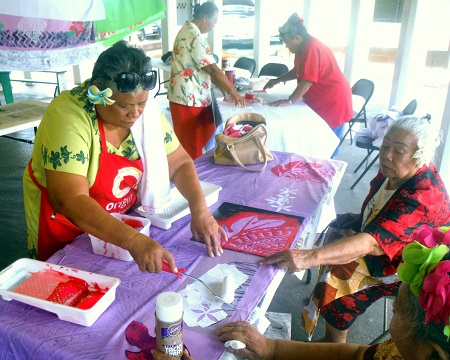
Participants in the TAOA Senior Community Service Employment Program create elei fabric during a workshop presented this summer by the ASCC Samoan Studies Institute. (Photo: J. Kneubuhl)

Participants in the TAOA Senior Community Service Employment Program create elei fabric during a workshop presented this summer by the ASCC Samoan Studies Institute. (Photo: J. Kneubuhl)

Participants in the TAOA Senior Community Service Employment Program create elei fabric during a workshop presented this summer by the ASCC Samoan Studies Institute. (Photo: J. Kneubuhl)
ASCC-SSI/TAOA Partnership Fosters Seniors Creativity
August 9, 2015
By James Kneubuhl, ASCC Press Officer
An ongoing partnership between the Samoan Studies Institute (SSI) at the American Samoa College (ASCC) and the Territorial Administration on Aging (TAOA) is helping to foster greater awareness of Samoan and Pacific culture for non-traditional students. Over the summer, staff from the SSI provided training in the modern Pacific art of elei (design printing on material) to a group of local senior citizens employed by the TAOA Senior Community Service Employment Program (SCSEP), enabling these seniors to learn a new skill rooted in traditional culture, which they can in turn not only pass along to others, but also develop for personal or commercial use.
SCSEP, a collaboration between TAOA and the US Department of Labor, makes available employment and self-development opportunities to the senior citizens of American Samoa. In keeping with this mission, SCSEP Program Director Mrs. Merieni Gutu networked with the SSI to hold the elei workshop for the benefit of interested SCSEP participants. More than a dozen seniors took the opportunity to attend the training sessions, which were offered at the TAOA compound in Pago Pago by SSI staff members Mrs. Tamari Mulitalo-Cheung, Mr. Patrick Mafo’e and Mr. Elisaia Mailo.
The art of elei combines elements of traditional “block printing” with recently introduced application methods to paint original designs on to blank material. The SSI staff explained both the cultural significance of elei as it has developed, as well as the full range of methods now used in its application. In a similar fashion as the application of designs to a siapo (tapa), the blank material can be laid over an “upeti” or wooden board with a visual motif carved into it, over which paint is applied to create a bold block print. Visual symbols can also be painted into the cloth using a “momi” made out of rubber, or simply painted on through a stencil. Mr. Mafo’e, the official Cultural Artist of the SSI, brought along some of the department’s own upeti boards, and also created some original stencil motifs over the duration of the workshop.
Mr. Mafo’e learned about elei while an apprentice to the renowned cultural artist Sven Ortquist, while Mrs. Mulitalo-Cheung’s expertise came from her sisters who attended Malua Theological College in Samoa. “One of the skills that a faletua must learn at Malua is how to make elei,” explained Mr. Mailo, “so Tamari was able to pick up from them.” Workshop coordinator Mr. Mailo, credited Mr. Mafo’e and Mrs. Mulitalo-Cheung for eliciting a highly positive response from the participating seniors. “Patrick taught them many different painting techniques, how to utilize materials at home if they do not have access to stencils, different printing patterns,” said Mr. Mailo, “and Tamari’s ability to work closely with the participants and make sure they were learning and interacting was exceptional.”
“One of our divisional goals is to promote community awareness of Samoa and the Pacific through SSI cultural extension programs,” continued Mr. Mailo. “By doing outreach projects such as this, we have an opportunity to teach or re-teach an aspect of the culture that not everyone in the community may not be familiar with. Any community programs that the SSI participates in or hosts are specific to the perpetuation of the fa’asamoa.”
For more information on the Samoan Studies Institute and its cultural programs, call ASCC at 699-9155 and ask for extension 347.
